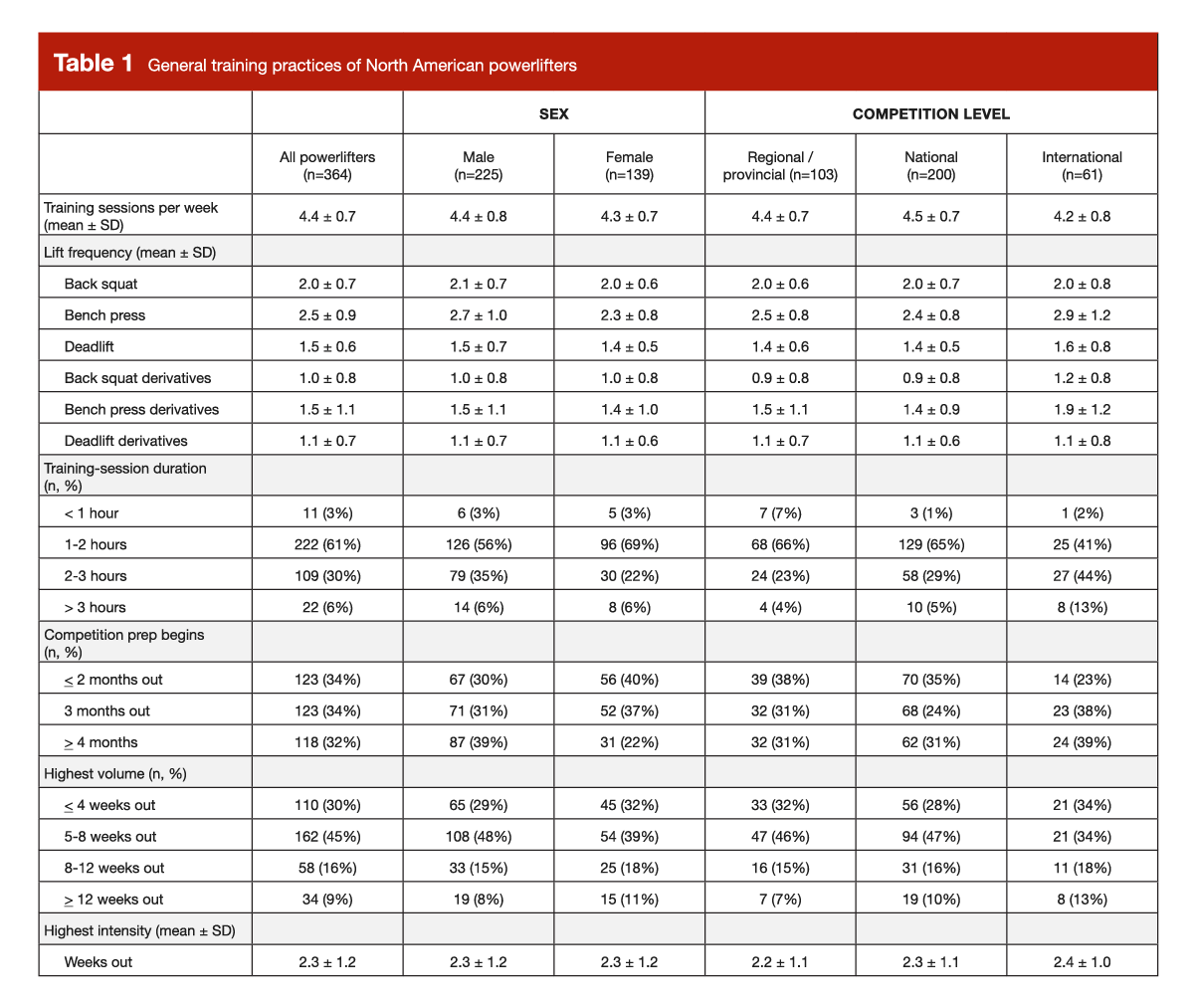We’ve lined tapering quite a lot of events in MASS (one, two, three, 4, 5), along with an great thought analysis by Dr. Hayden Pritchard, and a analysis of a analysis investigating the tapering practices of elite Croatian powerlifters. The analysis reviewed on this evaluation spotlight supplies to that physique of literature by documenting the tapering practices of an enormous sample of American and Canadian raw powerlifters. The prior analysis on Croatian lifters had merely 10 subjects, whereas the presently reviewed analysis included 364 subjects, thus giving us a higher understanding of usually used tapering practices.
The themes had been acknowledged using the OpenPowerlifting database (as a result of the researchers wished to survey people who had currently competed in sanctioned USAPL, CPU, or IPF competitions) and contacted via social media. The people completed a web-based survey about their teaching and tapering practices. For capabilities of examine, subjects had been break up by intercourse and opponents stage (regional/provincial, nationwide, and worldwide).
There have been a lot of outcomes. I’ll present the tables from the analysis, nevertheless, throughout the curiosity of defending this inside the scale of a typical evaluation non permanent, I’ll solely contact upon the outcomes I personally found attention-grabbing.
It appears that evidently frequent teaching variables (full teaching courses per week, teaching frequency for each increase, and complete teaching interval) had been pretty associated all through all ranges of opponents (Desk 1). The one slight distinction is that international-level powerlifters tended to have longer teaching courses than national- and regional-level rivals (57% of international-level lifters reported {{that a}} typical teaching session lasted 2+ hours, versus 28% of regional-level lifters and 34% of national-level lifters). Over 80% of lifters of all expertise ranges averaged 1-3 hours throughout the gymnasium per session; session interval for the international-level lifters merely skewed barely longer.
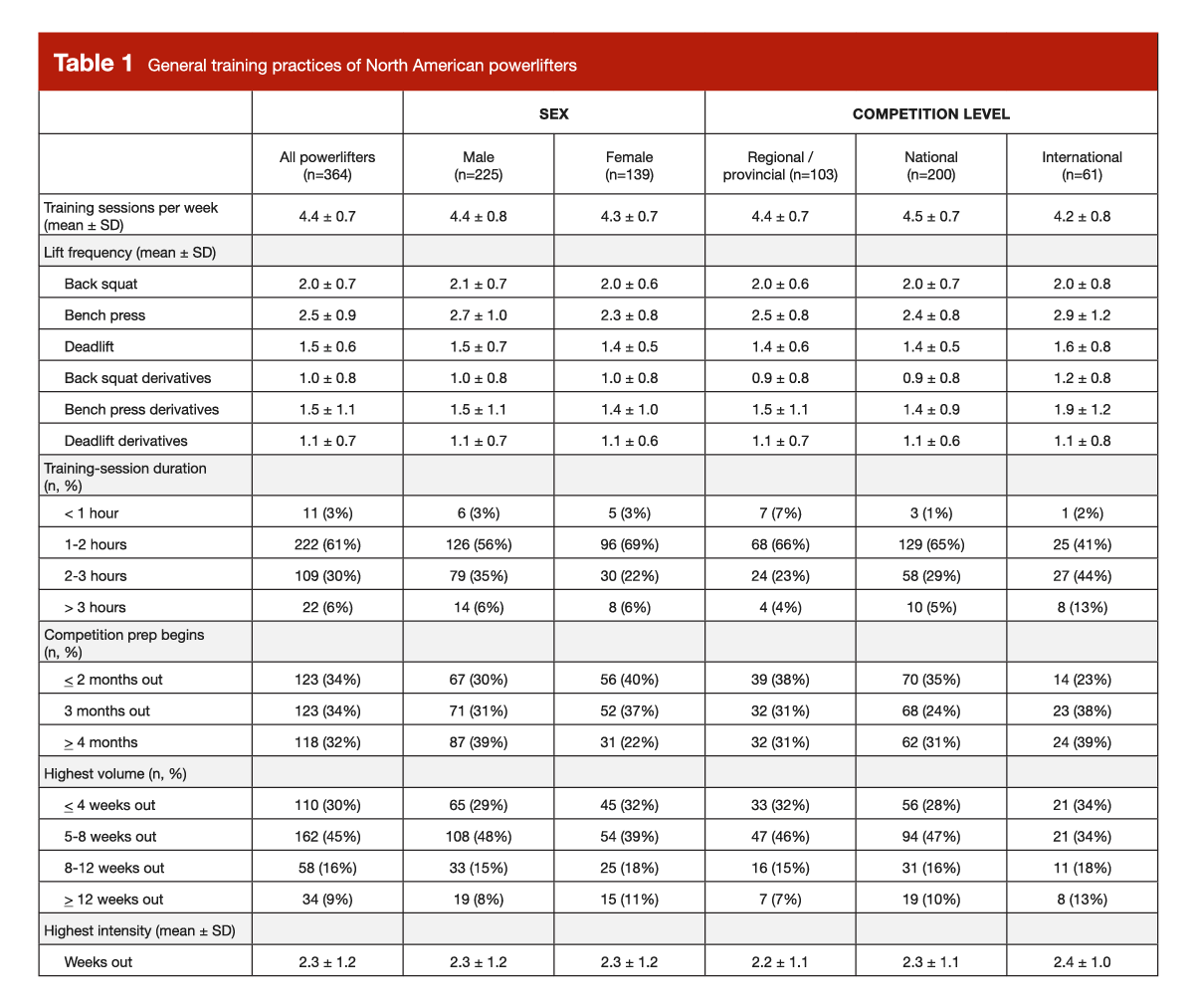
Step and linear tapers had been probably the most well-liked tapering fashions for powerlifters the least bit ranges. Tapers often lasted <10 days. Most lifters decreased their amount all through their taper, nevertheless they took diversified approaches when manipulating depth. Most lifters (79%) each elevated or decreased their teaching depth all through their taper; reducing depth was barely further frequent than rising depth for lifters the least bit ranges, nevertheless a hefty minority of lifters (31-36% all through all aggressive ranges) elevated depth all through their taper interval. An important distinction between the international-level lifters and the regional- and national-level lifters is that the overwhelming majority of international-level lifters (84%) decreased teaching interval all through their taper. Roughly half of the regional- and national-level lifters decreased teaching interval all through their taper, whereas roughly half maintained their typical teaching interval (Desk 2).
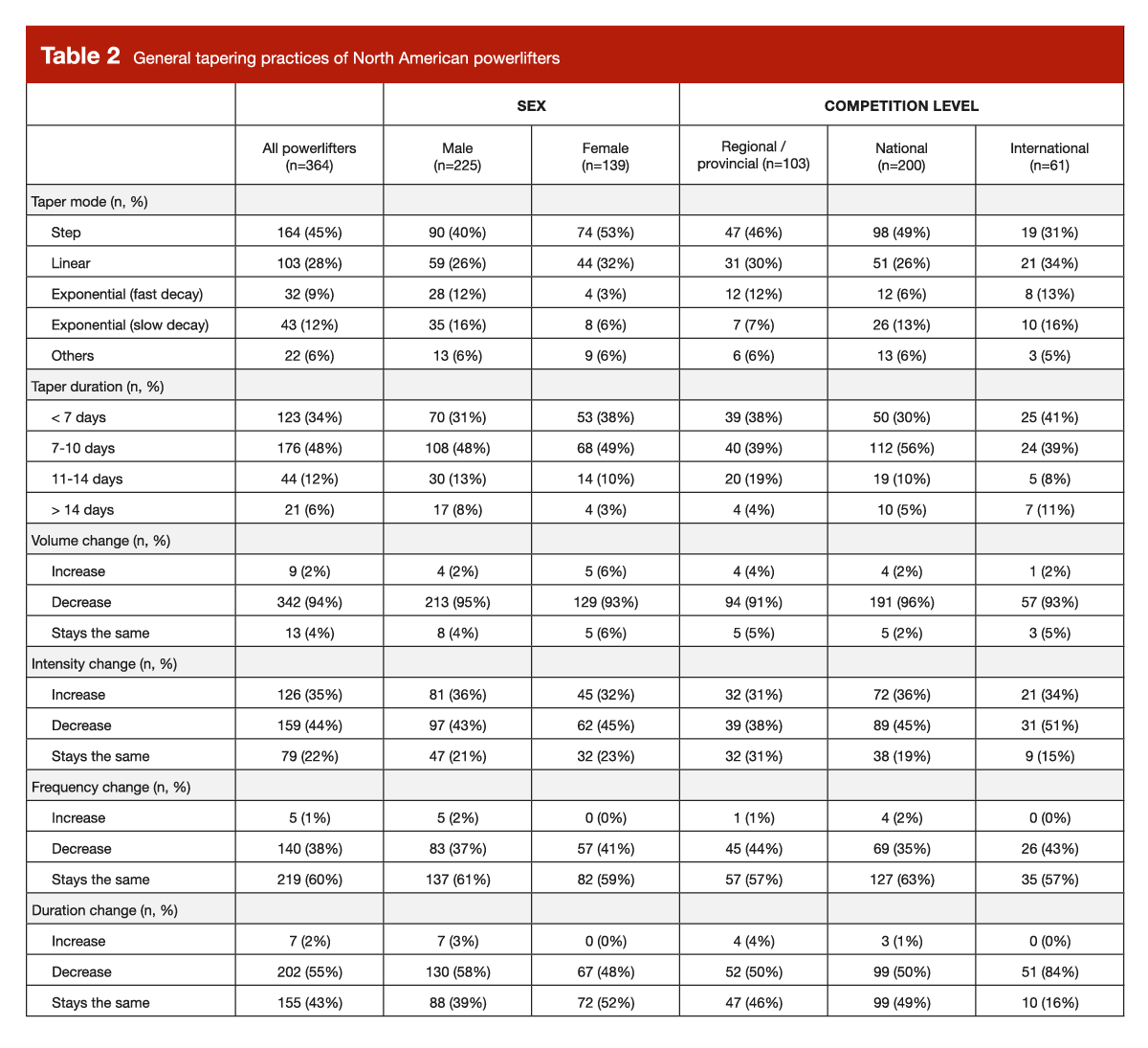
By way of the tapering interval, a plurality of lifters the least bit aggressive ranges completed their final heavy (>85% of 1RM) once more squat and deadlift courses 7-10 days out from the meet, whereas a majority completed their final heavy bench press session inside 7 days of the meet. Equally, plainly lifters of all aggressive ranges completed their last squat and bench press workouts (often with lighter lots of) about 4 days out from the meet, on frequent, and their final deadlift session about six days out from the meet (Desk 3).
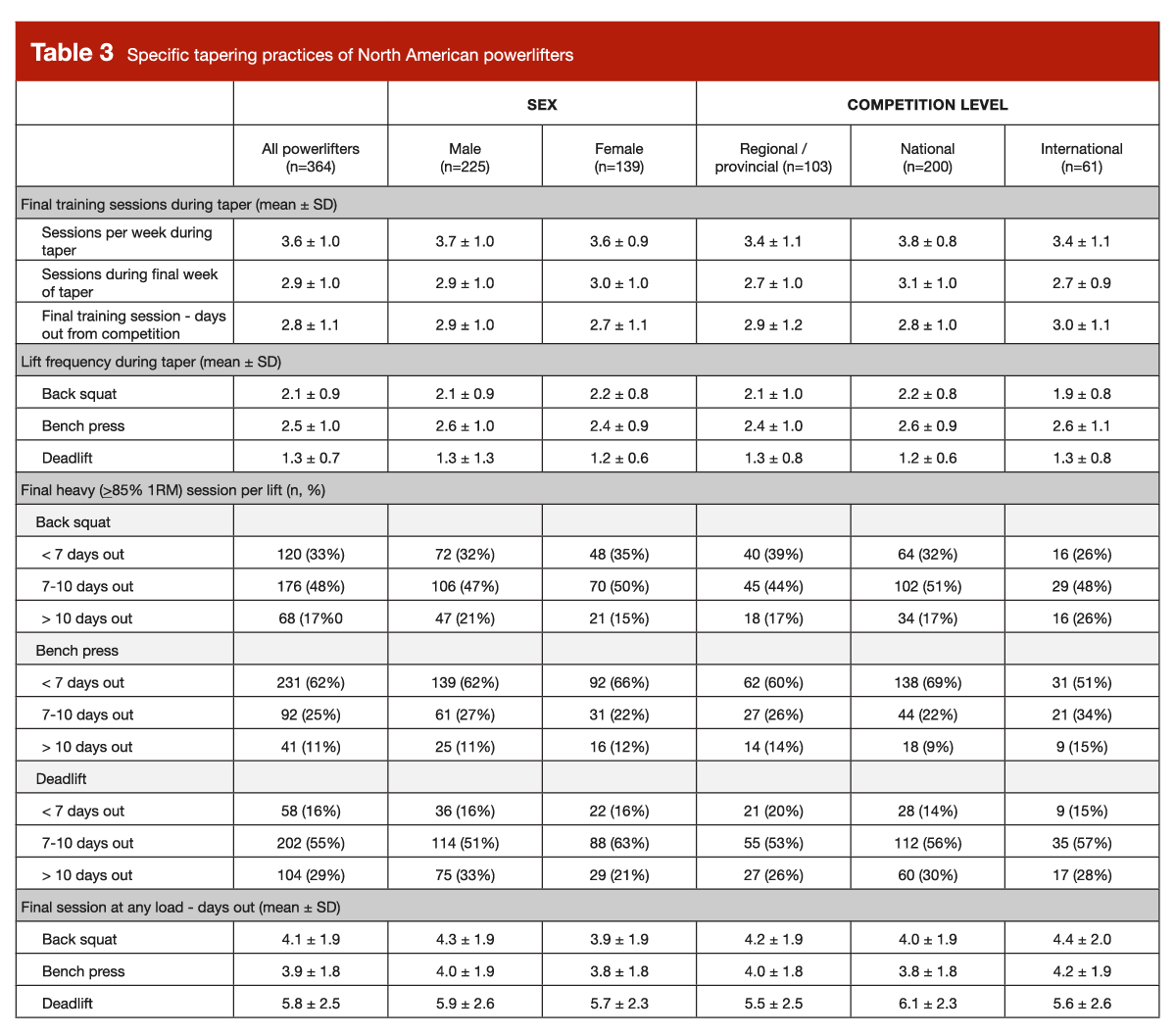
Together with teaching modifications, lifters engaged in quite a lot of totally different practices in the middle of the taper interval which can have an effect on restoration or opponents effectivity. Sleep and meditation, foam rolling, mobility work, dietary modifications (doable for the objective of making weight), therapeutic therapeutic massage, visualization work, and static stretching had been all pretty well-liked; these strategies had been employed by ~30-60% of lifters (Decide 1).
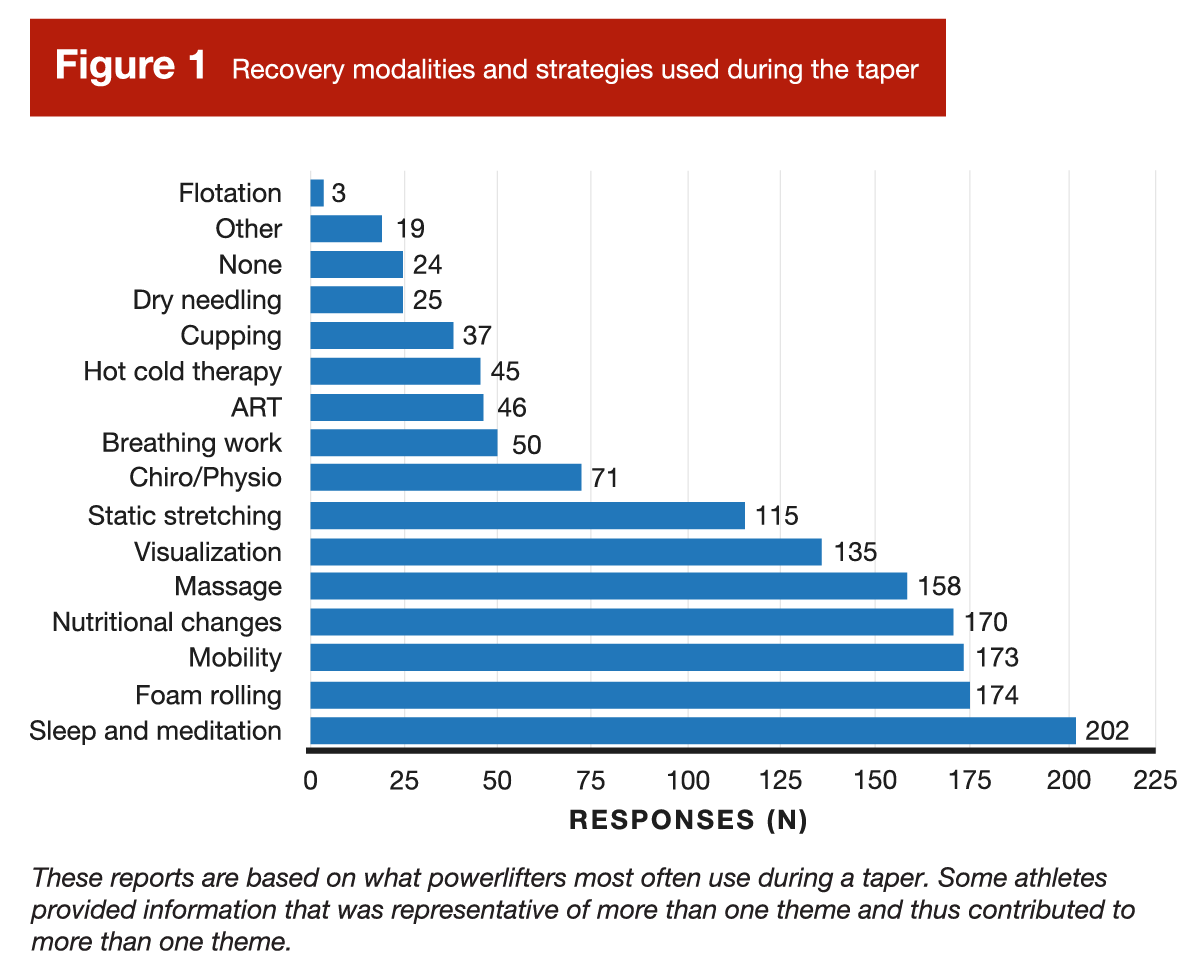
Lastly, the authors equipped a decide summarizing their findings. Decide 2 illustrates the usual tapering technique utilized by American and Canadian raw powerlifters.
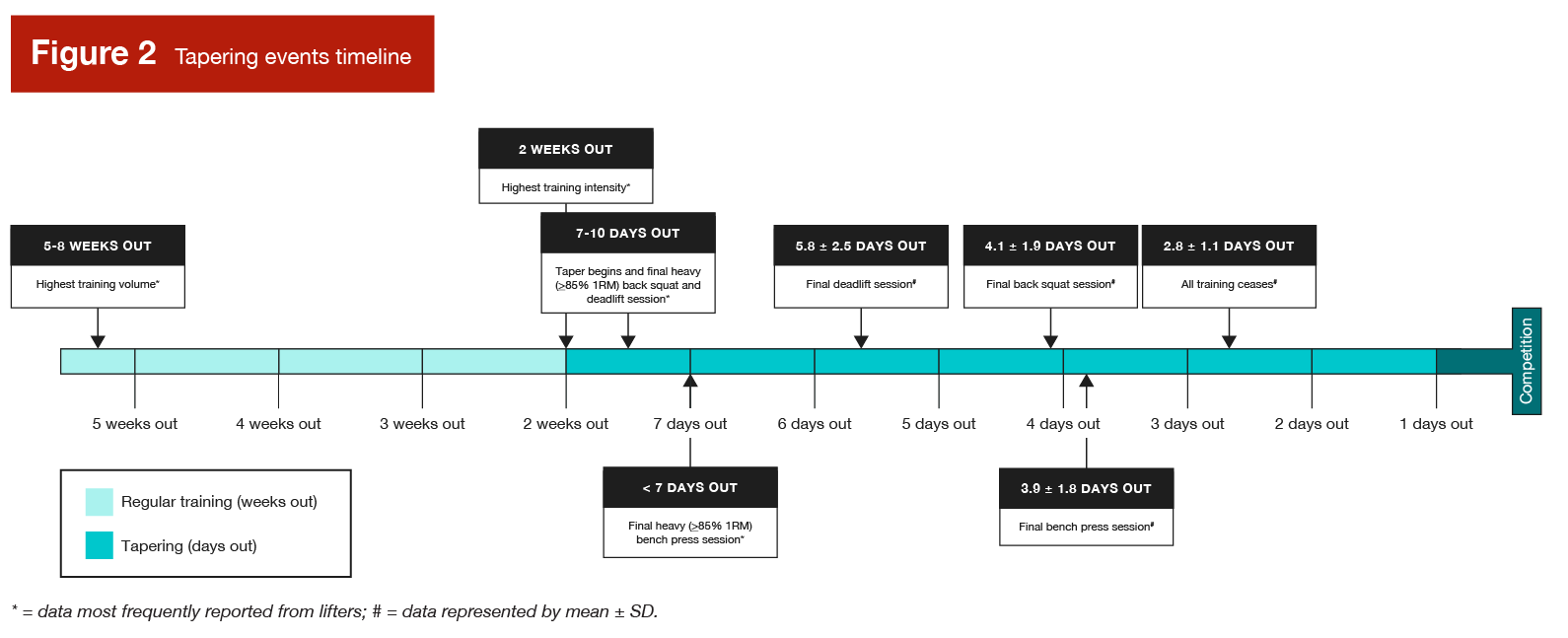
An important issue that jumped out at me was that lifters all through all ranges of opponents approached teaching and tapering very equally. In truth, complete teaching frequency, teaching interval, per-lift frequencies, sorts of tapers, and plenty of others. diversified between folks, nevertheless the suggest variations between the regional-level lifters, the national-level lifters, and the international-level lifters had been pretty small. That may counsel that the optimum approaches to powerlifting teaching are being discovered and disseminated all through all ranges of opponents, or it might merely counsel that there’s a bit of little bit of groupthink at work (I consider it’s doable a bit of bit of every). Importantly, I consider this discovering partially dispels the parable that international-level lifters are notably worthwhile on account of they make use of some explicit mix of teaching variables that dramatically improves their outcomes. This analysis signifies that, on frequent, international-level lifters would possibly apply a bit further (by means of frequent session interval) than totally different people, nevertheless their frequent technique to teaching doesn’t meaningfully differ from the norm.
The alternative issue that jumped out to me is {{that a}} plurality of lifters decreased teaching depth all through their tapers (notably the international-level lifters). Within the occasion you’ve spent lots time in powerlifting, this shouldn’t be a surprising discovering. Nonetheless, it conflicts with the “commonplace” tapering advice throughout the literature: it’s usually useful that athletes should protect or enhance depth (% of 1RM for his or her teaching lots of) all through a taper, whereas reducing amount. I’ve prolonged believed that this piece of advice doesn’t really apply to powerlifting. It’s primarily derived from analysis on endurance athletes or analysis using fairly simple energy assessments. I don’t have a tricky time believing you possibly can produce a ton of isometric knee extension torque 2-3 days after some high-intensity knee extensions, nevertheless I don’t assume you’ll have your biggest effectivity on the powerlifting platform 2-3 days after near-max deadlifts. In truth, the present analysis was a cross-sectional design, comparatively than an experimental analysis; as a result of this truth, it might’t conclusively arrange that reducing depth all through a powerlifting taper is superior to rising or sustaining depth all via a taper. Nonetheless, I’m personally comfortable with assuming that we’re seeing a bit of little bit of the “information of crowds.” If reducing depth all through a taper produced worse outcomes on the platform, I don’t assume it could possibly be as well-liked amongst rivals – notably international-level rivals. It’s moreover doable that I’m falling prey to a bit of little bit of groupthink on this matter (nevertheless I don’t assume I’m).
Lastly, it’s worth noting that the present analysis merely presents the usual technique to tapering utilized by American and Canadian powerlifters. It doesn’t arrange that the typical technique to tapering is unquestionably the optimum technique. It’s positively doable that we’ve been misled by customized, and we’re collectively missing out on superior strategies that each haven’t been tried or haven’t been popularized. I don’t assume it’s ludicrous to think about that the usual approaches work successfully enough for most people, as a rule (in another case, people would gravitate to totally different strategies), nevertheless it could possibly be presumptuous to confidently conclude that the most common tapering approaches are the best approaches.
This Evaluation Spotlight was initially printed in MASS Evaluation Evaluation. Subscribe to MASS to get a month-to-month publication with breakdowns of newest practice and food plan analysis.
Credit score rating: Graphics by Kat Whitfield.
Related
We’ve lined tapering quite a lot of events in MASS (one, two, three, 4, 5), along with an great thought analysis by Dr. Hayden Pritchard, and a analysis of a analysis investigating the tapering practices of elite Croatian powerlifters. The analysis reviewed on this evaluation spotlight supplies to that physique of literature by documenting the tapering practices of an enormous sample of American and Canadian raw powerlifters. The prior analysis on Croatian lifters had merely 10 subjects, whereas the presently reviewed analysis included 364 subjects, thus giving us a higher understanding of usually used tapering practices.
The themes had been acknowledged using the OpenPowerlifting database (as a result of the researchers wished to survey people who had currently competed in sanctioned USAPL, CPU, or IPF competitions) and contacted via social media. The people completed a web-based survey about their teaching and tapering practices. For capabilities of examine, subjects had been break up by intercourse and opponents stage (regional/provincial, nationwide, and worldwide).
There have been a lot of outcomes. I’ll present the tables from the analysis, nevertheless, throughout the curiosity of defending this inside the scale of a typical evaluation non permanent, I’ll solely contact upon the outcomes I personally found attention-grabbing.
It appears that evidently frequent teaching variables (full teaching courses per week, teaching frequency for each increase, and complete teaching interval) had been pretty associated all through all ranges of opponents (Desk 1). The one slight distinction is that international-level powerlifters tended to have longer teaching courses than national- and regional-level rivals (57% of international-level lifters reported {{that a}} typical teaching session lasted 2+ hours, versus 28% of regional-level lifters and 34% of national-level lifters). Over 80% of lifters of all expertise ranges averaged 1-3 hours throughout the gymnasium per session; session interval for the international-level lifters merely skewed barely longer.

Step and linear tapers had been probably the most well-liked tapering fashions for powerlifters the least bit ranges. Tapers often lasted <10 days. Most lifters decreased their amount all through their taper, nevertheless they took diversified approaches when manipulating depth. Most lifters (79%) each elevated or decreased their teaching depth all through their taper; reducing depth was barely further frequent than rising depth for lifters the least bit ranges, nevertheless a hefty minority of lifters (31-36% all through all aggressive ranges) elevated depth all through their taper interval. An important distinction between the international-level lifters and the regional- and national-level lifters is that the overwhelming majority of international-level lifters (84%) decreased teaching interval all through their taper. Roughly half of the regional- and national-level lifters decreased teaching interval all through their taper, whereas roughly half maintained their typical teaching interval (Desk 2).

By way of the tapering interval, a plurality of lifters the least bit aggressive ranges completed their final heavy (>85% of 1RM) once more squat and deadlift courses 7-10 days out from the meet, whereas a majority completed their final heavy bench press session inside 7 days of the meet. Equally, plainly lifters of all aggressive ranges completed their last squat and bench press workouts (often with lighter lots of) about 4 days out from the meet, on frequent, and their final deadlift session about six days out from the meet (Desk 3).

Together with teaching modifications, lifters engaged in quite a lot of totally different practices in the middle of the taper interval which can have an effect on restoration or opponents effectivity. Sleep and meditation, foam rolling, mobility work, dietary modifications (doable for the objective of making weight), therapeutic therapeutic massage, visualization work, and static stretching had been all pretty well-liked; these strategies had been employed by ~30-60% of lifters (Decide 1).

Lastly, the authors equipped a decide summarizing their findings. Decide 2 illustrates the usual tapering technique utilized by American and Canadian raw powerlifters.

An important issue that jumped out at me was that lifters all through all ranges of opponents approached teaching and tapering very equally. In truth, complete teaching frequency, teaching interval, per-lift frequencies, sorts of tapers, and plenty of others. diversified between folks, nevertheless the suggest variations between the regional-level lifters, the national-level lifters, and the international-level lifters had been pretty small. That may counsel that the optimum approaches to powerlifting teaching are being discovered and disseminated all through all ranges of opponents, or it might merely counsel that there’s a bit of little bit of groupthink at work (I consider it’s doable a bit of bit of every). Importantly, I consider this discovering partially dispels the parable that international-level lifters are notably worthwhile on account of they make use of some explicit mix of teaching variables that dramatically improves their outcomes. This analysis signifies that, on frequent, international-level lifters would possibly apply a bit further (by means of frequent session interval) than totally different people, nevertheless their frequent technique to teaching doesn’t meaningfully differ from the norm.
The alternative issue that jumped out to me is {{that a}} plurality of lifters decreased teaching depth all through their tapers (notably the international-level lifters). Within the occasion you’ve spent lots time in powerlifting, this shouldn’t be a surprising discovering. Nonetheless, it conflicts with the “commonplace” tapering advice throughout the literature: it’s usually useful that athletes should protect or enhance depth (% of 1RM for his or her teaching lots of) all through a taper, whereas reducing amount. I’ve prolonged believed that this piece of advice doesn’t really apply to powerlifting. It’s primarily derived from analysis on endurance athletes or analysis using fairly simple energy assessments. I don’t have a tricky time believing you possibly can produce a ton of isometric knee extension torque 2-3 days after some high-intensity knee extensions, nevertheless I don’t assume you’ll have your biggest effectivity on the powerlifting platform 2-3 days after near-max deadlifts. In truth, the present analysis was a cross-sectional design, comparatively than an experimental analysis; as a result of this truth, it might’t conclusively arrange that reducing depth all through a powerlifting taper is superior to rising or sustaining depth all via a taper. Nonetheless, I’m personally comfortable with assuming that we’re seeing a bit of little bit of the “information of crowds.” If reducing depth all through a taper produced worse outcomes on the platform, I don’t assume it could possibly be as well-liked amongst rivals – notably international-level rivals. It’s moreover doable that I’m falling prey to a bit of little bit of groupthink on this matter (nevertheless I don’t assume I’m).
Lastly, it’s worth noting that the present analysis merely presents the usual technique to tapering utilized by American and Canadian powerlifters. It doesn’t arrange that the typical technique to tapering is unquestionably the optimum technique. It’s positively doable that we’ve been misled by customized, and we’re collectively missing out on superior strategies that each haven’t been tried or haven’t been popularized. I don’t assume it’s ludicrous to think about that the usual approaches work successfully enough for most people, as a rule (in another case, people would gravitate to totally different strategies), nevertheless it could possibly be presumptuous to confidently conclude that the most common tapering approaches are the best approaches.
This Evaluation Spotlight was initially printed in MASS Evaluation Evaluation. Subscribe to MASS to get a month-to-month publication with breakdowns of newest practice and food plan analysis.
Credit score rating: Graphics by Kat Whitfield.
